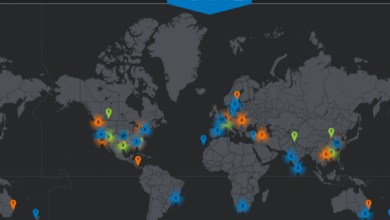
CIO Emerging Tech Best Practices: A Guide to Digital Transformation
CIO Emerging Tech Best Practices: A Guide to Digital Transformation is a crucial topic for any organization navigating the rapidly evolving tech landscape. The role of the CIO has drastically shifted in recent years, moving beyond traditional IT management to encompass strategic leadership in driving digital transformation initiatives.
As emerging technologies like AI, cloud computing, and blockchain reshape businesses, CIOs must adapt and implement best practices to ensure their organizations stay ahead of the curve.
This guide delves into the challenges and opportunities associated with embracing these technologies, providing a framework for CIOs to effectively manage and implement them. We’ll explore how to develop a robust IT strategy aligned with business goals, foster a culture of innovation, and address the unique security threats posed by emerging technologies.
Ultimately, this guide aims to empower CIOs to build a future-ready IT team and maximize the value of emerging technology investments.
Building a Future-Ready IT Team

In today’s rapidly evolving technological landscape, organizations need to prioritize building a future-ready IT team. This involves developing a skilled and adaptable workforce capable of navigating the ever-changing technological landscape and leveraging emerging technologies to drive innovation and achieve business goals.
Attracting and Retaining Top Talent
Attracting and retaining top talent is crucial for building a future-ready IT team. Organizations need to create an environment that attracts and retains individuals with expertise in emerging technologies, such as artificial intelligence, cloud computing, cybersecurity, and data analytics.Here are some strategies for attracting and retaining top talent:
- Offer competitive compensation and benefits packages:This includes salaries, bonuses, and benefits that are competitive with other companies in the industry.
- Provide opportunities for professional development:Organizations should invest in training and development programs to help their employees stay up-to-date with the latest technologies and trends.
- Create a culture of innovation:Encourage employees to experiment with new technologies and share their ideas.
- Foster a positive and inclusive work environment:This includes creating a culture of respect, collaboration, and open communication.
Training and Upskilling Programs
Training and upskilling programs play a critical role in equipping IT professionals with the necessary skills to navigate the evolving technology landscape. Organizations should invest in programs that cover emerging technologies, such as:
- Artificial intelligence (AI):AI is transforming various industries, and IT professionals need to understand its concepts, applications, and ethical implications.
- Cloud computing:Cloud computing is becoming increasingly prevalent, and IT professionals need to be proficient in cloud platforms and services.
- Cybersecurity:Cybersecurity threats are becoming more sophisticated, and IT professionals need to stay up-to-date with the latest security measures and best practices.
- Data analytics:Data analytics is crucial for making data-driven decisions, and IT professionals need to understand how to collect, analyze, and interpret data.
Organizations can leverage various training methods, including online courses, boot camps, workshops, and mentorship programs, to provide their employees with the necessary skills.
Measuring the Impact of Emerging Technologies: Cio Emerging Tech Best Practices

In the fast-paced world of technology, it is crucial for CIOs to not only embrace emerging technologies but also demonstrate their value to stakeholders. Measuring the impact of these investments is essential to justify spending, secure future funding, and ensure that digital transformation initiatives align with organizational goals.
Establishing a Framework for Measuring ROI and Impact, Cio emerging tech best practices
A robust framework for measuring the ROI and impact of emerging technology investments should be established. This framework should encompass both quantitative and qualitative metrics to provide a comprehensive picture of the technology’s value.
- Define Clear Objectives and Metrics:Before implementing any emerging technology, clearly define the desired outcomes and establish specific, measurable, achievable, relevant, and time-bound (SMART) objectives. Identify key performance indicators (KPIs) that directly align with these objectives. For example, if the goal is to improve customer satisfaction, KPIs could include customer churn rate, Net Promoter Score (NPS), and average resolution time.
- Baseline and Benchmarking:Establish a baseline measurement before implementing the technology. This provides a starting point for comparing progress and identifying improvements. Benchmarking against industry standards or competitors can also provide valuable insights into performance and identify areas for optimization.
- Track and Monitor Progress:Continuously track and monitor the KPIs throughout the technology implementation and adoption phases. Regularly analyze data and identify trends to assess the impact of the technology on the organization.
- Cost-Benefit Analysis:Conduct a thorough cost-benefit analysis to evaluate the financial return on investment. Consider both tangible and intangible benefits. Tangible benefits may include increased revenue, reduced costs, and improved efficiency. Intangible benefits could include enhanced customer satisfaction, improved employee productivity, and a competitive advantage.
- Qualitative Feedback:Gather qualitative feedback from stakeholders, including employees, customers, and partners. This feedback provides valuable insights into the technology’s impact on user experience, process efficiency, and overall satisfaction.
Key Performance Indicators (KPIs) for Digital Transformation Initiatives
Several KPIs can be used to track the success of digital transformation initiatives. These KPIs can be grouped into different categories based on their focus area:
- Operational Efficiency:Metrics that measure improvements in operational efficiency, such as reduced processing time, increased throughput, and decreased error rates. Examples include:
- Average Transaction Time:Measures the time taken to complete a specific transaction or process.
- Cycle Time:Tracks the time required to complete a specific task or process from start to finish.
- Error Rate:Measures the percentage of transactions or processes that result in errors or failures.
- Customer Experience:Metrics that measure the impact of digital transformation on customer experience, such as increased customer satisfaction, improved customer retention, and enhanced brand loyalty. Examples include:
- Customer Satisfaction Score (CSAT):Measures customer satisfaction with specific products, services, or interactions.
- Net Promoter Score (NPS):Measures customer loyalty and willingness to recommend a product or service.
- Customer Churn Rate:Tracks the percentage of customers who discontinue their relationship with the organization.
- Financial Performance:Metrics that measure the financial impact of digital transformation, such as increased revenue, reduced costs, and improved profitability. Examples include:
- Return on Investment (ROI):Measures the financial return generated by an investment.
- Cost Savings:Tracks the amount of money saved through process automation, efficiency improvements, or reduced operational costs.
- Revenue Growth:Measures the increase in revenue generated by the digital transformation initiative.
- Employee Productivity:Metrics that measure the impact of digital transformation on employee productivity, such as increased efficiency, improved collaboration, and reduced workload. Examples include:
- Employee Satisfaction:Measures employee satisfaction with their work environment, tools, and processes.
- Time Spent on Tasks:Tracks the amount of time employees spend on specific tasks or projects.
- Number of Tasks Completed:Measures the number of tasks or projects completed within a given timeframe.
Demonstrating the Value of Emerging Technologies to Stakeholders
CIOs can demonstrate the value of emerging technologies to stakeholders by:
- Communicating Results Clearly and Concisely:Use data visualizations, dashboards, and concise reports to communicate the impact of emerging technologies in a clear and compelling way. Highlight key metrics, trends, and achievements.
- Focus on Business Value:Frame the impact of emerging technologies in terms of business value, aligning with organizational goals and priorities. Demonstrate how these technologies contribute to revenue growth, cost savings, improved customer satisfaction, or enhanced employee productivity.
- Showcase Success Stories:Share compelling success stories and case studies that demonstrate the positive impact of emerging technologies. Highlight real-world examples of how these technologies have solved business problems, improved processes, or created new opportunities.
- Engage with Stakeholders:Actively engage with stakeholders, including executives, employees, and customers, to gather feedback and share updates on the progress of digital transformation initiatives. Transparency and communication are key to building trust and demonstrating value.
As a CIO, staying ahead of emerging tech trends is crucial. But even with cutting-edge technology, efficient administration is vital. That’s where streamlining payroll processes comes in, and for churches, choosing the right service is key. Check out this list of top church payroll services to find the perfect fit for your organization.
By implementing the best practices in both emerging tech and administrative efficiency, you can empower your church to focus on its core mission.
Staying ahead of the curve in emerging technologies is crucial for any CIO, and that includes understanding the latest trends in financial reporting. A recent announcement from Stack Capital Group Inc. regarding a change in their independent auditor, which you can read about here , highlights the importance of transparency and accountability in the digital age.
This kind of news serves as a reminder for CIOs to be proactive in implementing robust cybersecurity measures and staying informed about evolving regulations within their respective industries.
Staying ahead of the curve in CIO emerging tech best practices means constantly evaluating and adapting to new trends. One inspiring example of innovation is the Elsie’s Fashion Challenge April Update , where designers are pushing the boundaries of sustainability and technology in fashion.
This kind of creative thinking, combined with a deep understanding of emerging technologies, is essential for CIOs to lead their organizations into the future.







